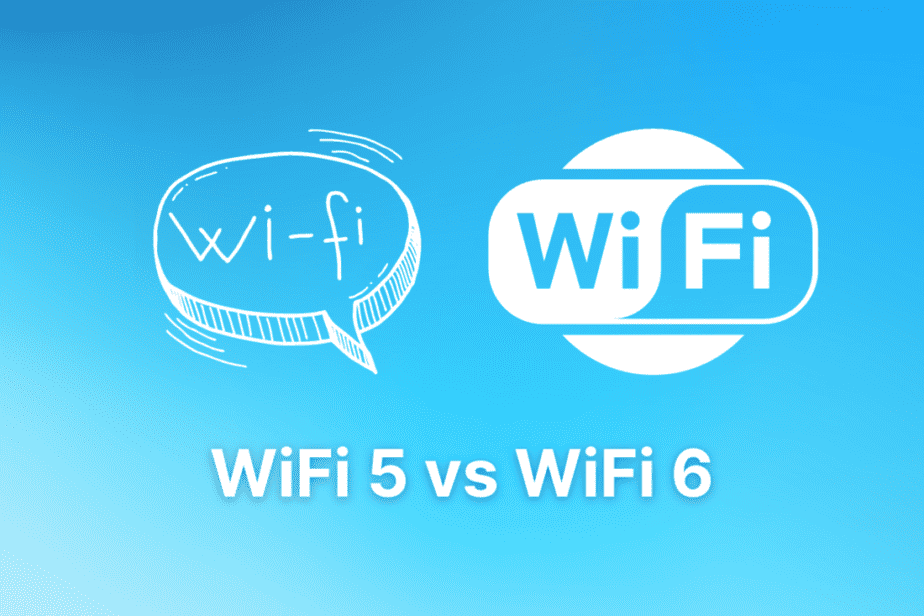WiFi 5 vs WiFi 6: 5 Differences You Must Know! (Explained)
We’re reader-supported; we may earn a commission from links in this article.
Ever struggled with slow internet speeds and constant buffering while streaming your favorite shows? You’re not alone. Every day, our homes are becoming more connected, and the demand for faster, more efficient wireless networks is growing.
Enter WiFi 5 and WiFi 6, the two latest generations of wireless networking protocols. But what exactly are the differences between these two technologies, and how will they impact your online experience?

In this blog post, we’ll explore the key differences between WiFi 5 vs WiFi 6, shedding light on their features, performance, and what the future holds for wireless networking.
Read on to understand their nuances more!
Short Summary
- WiFi 6 offers increased speed and performance, device compatibility and support, backward compatibility with older devices, enhanced security features such as WPA3 encryption, improved energy efficiency for connected devices.
- WiFi 6E is an extension of WiFi 6 that utilizes the 6GHz frequency band to offer faster speeds and decreased latency while increasing capacity in congested networks.
- With its advanced capabilities, WiFi6E promises to revolutionize wireless networks by providing improved network performance for homes with multiple devices.
Understanding WiFi 5 and WiFi 6
As our homes become filled with more devices, from smart TVs to thermostats, the need for a wireless network that can efficiently manage multiple devices has become essential. Enter WiFi 5 and WiFi 6.
Both endorsed by the WiFi Alliance, these two generations of wireless communication protocols are designed to efficiently transfer data, offer faster speeds, and improve network efficiency.
So, what sets them apart? Let’s dive into the details of these two revolutionary WiFi standards.
What is WiFi 5?
Wi-Fi 5, or the fifth generation of the 802.11ac wireless networking protocol, was introduced in 2014 to tackle the growing demand for connected devices.
Boasting faster speeds and improved features, wi fi 5 supports beamforming, MU-MIMO, 160MHz channel width support, and four spatial streams. These enhancements allow for more devices to be connected simultaneously and improve overall network performance.
With a theoretical maximum of data transfer speeds reaching 6.9 Gbps, WiFi 5 was a significant leap forward in wireless data transmission. Its utilization of 256-QAM modulation and the ability to support up to four devices using MU-MIMO technology made it a popular choice for homes and offices alike.
However, the increasing demand for even faster and more efficient networks paved the way for the emergence of wi fi 6.
What is WiFi 6?
WiFi 6, or 802.11ax, is the latest generation of wireless networking protocol, designed to enhance speed, efficiency, and device support, especially in dense environments.
Its primary purpose is to effectively manage network congestion, which has become increasingly problematic with the growing number of connected devices.
Key features of WiFi 6 include orthogonal frequency division multiplexing (OFDM), orthogonal frequency-division multiple access (OFDMA), an updated MU-MIMO, Target Wake Time (TWT) for energy efficiency on mobile and IoT devices, and WPA3 encryption for increased security. These technologies allow WiFi 6 to provide increased speed and range, utilizing both the 5 GHz and 2.4 GHz frequency bands for optimal performance.
Differences Between WiFi 5 vs WiFi 6
Now that we have a basic understanding of WiFi 5 and WiFi 6, let’s dive into the key differences between these two technologies.
We’ll explore how they differ in terms of speed and performance, device compatibility and support, backward compatibility, security features, and energy efficiency.
Speed and performance are the most obvious differences between WiFi 5 and WiFi 6. WiFi 6 offers free WiFi.
1. Speed and Performance
Perhaps the most noticeable difference between WiFi 5 and WiFi 6 is their speed capabilities. WiFi 6 offers an increase of 39.13% in speed compared to WiFi 5, with a maximum speed of up to 9.6 Gbps.
This speed boost is achieved through the integration of technologies like OFDMA, MU-MIMO, beamforming, and 1024 quadrature amplitude modulation (QAM).
WiFi 6 also provides a significant improvement in performance when handling multiple devices on a network. By optimizing the way routers and connected devices interact and expanding the number of devices able to communicate simultaneously from four to eight, WiFi 6 ensures a smoother online experience, even in crowded networks.
2. Device Compatibility and Support
When it comes to device compatibility and support, WiFi 6 shines. Thanks to bidirectional MU-MIMO and OFDMA technologies, WiFi 6 can facilitate more concurrent connections and improved network management.
Additionally, it enables devices to switch between 2.4GHz and 5GHz bands for the best signal strength, avoiding interference and selecting the least congested band.
As smart devices continue to proliferate, WiFi 6’s enhanced device support becomes increasingly important. A densely populated network of smart devices could experience a 400% improvement in data throughput density with WiFi 6. This makes it an ideal choice for homes and corporate offices with multiple users and a variety of connected devices.
3. Backward Compatibility
Backward compatibility is a crucial aspect when considering upgrading to a new WiFi standard. Both WiFi 5 and WiFi 6 are backward compatible with older devices, meaning they can work with devices utilizing earlier versions of the wireless networking protocols.
However, it is important to note that when a WiFi 6 device is connected to a WiFi 5 router, the performance of the device will be constrained to the lower speed of the WiFi 5 router. While both standards offer backward compatibility, WiFi 6’s improved performance and features make it the superior choice when used with compatible devices.
4. Enhanced Security Features
Security is a paramount concern for any wireless network. As cyber threats continue to evolve, it is essential to have the latest security protocols in place. WiFi 6 introduces enhanced security features, such as WPA3 encryption, providing better protection for wireless networks compared to WiFi 5’s WPA2 protocol.
WPA3 offers improved encryption processes and multi-factor authentication, ensuring your wireless network is better protected from potential threats. With the growing number of connected devices in our homes and offices, upgrading to WiFi 6 not only offers improved performance but also enhanced security.
5. Energy Efficiency and Battery Life
Energy efficiency is another key factor to consider when comparing WiFi 5 and WiFi 6. WiFi 6 improves energy efficiency and battery life for connected devices, thanks to features like Target Wake Time (TWT), which optimizes power consumption.
TWT allows devices to intelligently manage the timing of their WiFi activity, leading to increased sleep time and decreased power consumption.
This can be particularly beneficial for battery-powered devices connected, such as smartphones, tablets, and IoT devices, as it helps extend their battery life and reduce the need for frequent charging. Electrical and electronics engineers play a crucial role in designing energy-efficient systems for these devices.
The Future: WiFi 6E and Beyond
As the demand for faster and more efficient wireless networks continues to grow, the world of wi fi is evolving at a rapid pace thanks to the efforts of electronics engineers. The future of wireless networking lies with WiFi 6E and beyond.
So, what exactly is WiFi 6E, and what implications does it have for network congestion and latency?
What is WiFi 6E?
WiFi 6E is an extension of WiFi 6, introducing the 6GHz frequency band for even faster speeds, reduced latency, and improved network performance. This new standard takes the advancements of WiFi 6 and pushes the boundaries even further, delivering enhanced speeds, decreased latency, increased capacity, broader channels, and better performance compared to its predecessors.
By utilizing the 6GHz frequency band, WiFi 6E offers more bandwidth and reduced congestion, resulting in improved performance and decreased latency. This makes it an ideal choice for high density environments and the ever-growing number of connected devices.
Implications for Network Congestion and Latency
WiFi 6E’s additional frequency band will help alleviate network congestion and latency issues, making it ideal for high density environments and the growing number of connected devices.
As more devices join the wireless network, the need for a solution that can efficiently manage network congestion and minimize latency becomes increasingly important.
With its ability to provide enhanced speeds, improved network efficiency, and increased capacity, WiFi 6E offers a promising solution to the challenges of network congestion and latency.
As technology continues to advance and our reliance on wireless networks grows, the future of WiFi 6E and beyond is bright.
Summary
In conclusion, the evolution of WiFi standards has brought significant improvements in speed, performance, device compatibility, security, and energy efficiency.
While WiFi 5 was a step forward in wireless networking, WiFi 6 takes it to new heights, offering even faster speeds, better device support, and enhanced security features.
As the demand for more efficient and reliable wireless networks continues to grow, the future of WiFi 6E and beyond holds great promise.
So whether you’re streaming your favorite show or working from home, embracing the advancements of WiFi 6 and its successors will ensure a seamless online experience for years to come.
Frequently Asked Questions
Does Wi-Fi 6 go through walls better?
WiFi 6 can still struggle to penetrate thick walls and floors when operated on a standard home router network.
Which devices are Wi-Fi 6 compatible?
The latest laptops, phones and tablets are all compatible with WiFi 6, enabling you to take full advantage of your router’s capabilities.
What are the benefits of Wi-Fi 6?
With Wi-Fi 6, you can enjoy increased capacity for more connected devices, better coverage, more bandwidth for each user, enhanced security, lower latency for gamers, and improved speed. This cutting-edge technology provides faster throughput speeds, better battery life, and less bandwidth congestion than what you get with Wi-Fi 5 (802.11ac) technology, making it easy to find router and client devices at all prices to harness its powerful potential.
How do I know if I have Wi-Fi 6?
To determine if you have Wi-Fi 6, check the firmware version of your router or look up the make and model.
You can also view the Wi-Fi network properties to see if the Protocol is set to Wi-Fi 6 (802.11ax).
What is the primary difference between WiFi 5 and WiFi 6?
WiFi 6 offers faster data transfer speeds and improved performance compared to WiFi 5, especially when multiple devices are connected.
It is especially beneficial in households with multiple devices connected to the same network, as it can reduce latency and improve overall performance.

Justin Chia
Justin is the author of Justjooz and is a data analyst and AI expert. He is also a Nanyang Technological University (NTU) alumni, majoring in Biological Sciences.
He regularly posts AI and analytics content on LinkedIn, and writes a weekly newsletter, The Juicer, on AI, analytics, tech, and personal development.
To unwind, Justin enjoys gaming and reading.






